Anyone who’s ever stared longingly at those Instagram-worthy coffee shop creations knows the allure of latte art.
While baristas make it look effortless, most first-timers end up with something resembling a blob rather than a beautiful heart. But here’s the thing: those coffee pros weren’t born wielding steam wands like magic wands.
From wobbly hearts to misshapen swans, every masterpiece starts with a few failed attempts. Ready to transform your morning cup from basic to beautiful?
Quick Summary
- Basic heart design is ideal for beginners, requiring only three steps: pouring steamed milk, wiggling through, and drawing a clean line.
- Simple dot patterns serve as an entry point to latte art, focusing on pouring thin streams of milk from above.
- The easy apple design involves three beginner-friendly moves: creating a round blob, stem, and leaf shape.
- Bear face designs bring smiles using basic circles for ears and face, making imperfections part of their charm.
- Basic leaf patterns create fern-like designs using gentle wiggle motions and a steady center pour.
The Basic Heart: Starting With the Simplest Design

The humble heart design stands as the perfect starting point for aspiring latte artists, much like training wheels on a bicycle. Even seasoned baristas admit they spent weeks mastering this deceptively simple pattern before moving on to more complex designs.
Break it down to the basics – mastering coffee art is like following a dance, with each step flowing into the next.
The process breaks down into three key steps:
- Pour steamed milk steadily into the center
- Pull through with a gentle wiggle
- Draw a clean line through the middle
Like most first-time romances, initial attempts often end up looking more like blobs than hearts. But don’t despair! Many baristas joke that their early hearts looked more like anatomically correct organs than the cute Valentine’s Day variety.
With practice, those misshapen puddles gradually transform into Instagram-worthy hearts that would make any coffee lover swoon.
Creating a Simple Dot Pattern
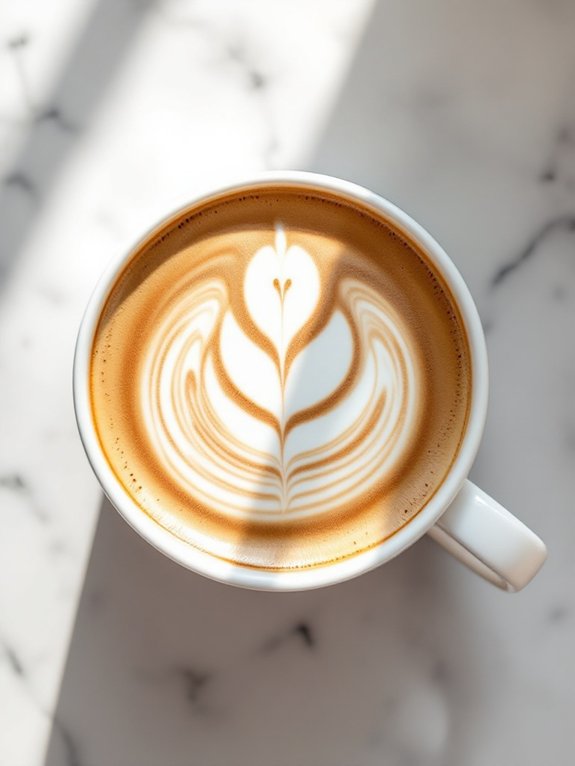
Many latte artists consider dot patterns their “gateway drug” into more complex designs, since these simple spots of milk can transform an ordinary espresso into something that looks deliberately artistic, even when they’re slightly wonky.
Creating dots is surprisingly straightforward:
- Hold the pitcher about an inch above the coffee
- Pour a thin stream steadily into one spot
- Watch the white dot magically appear
- Move to the next spot and repeat
The trick is spacing the dots evenly – though let’s be honest, most beginners end up with something that looks more like a coffee-based constellation map than a perfect circle pattern. But that’s part of the charm!
Even professional baristas started somewhere, probably making the same lumpy, misshapen dots that now grace your morning coffee.
Remember: Embrace the imperfection. Your wonky dots have personality!
Mastering the Classic Rosetta
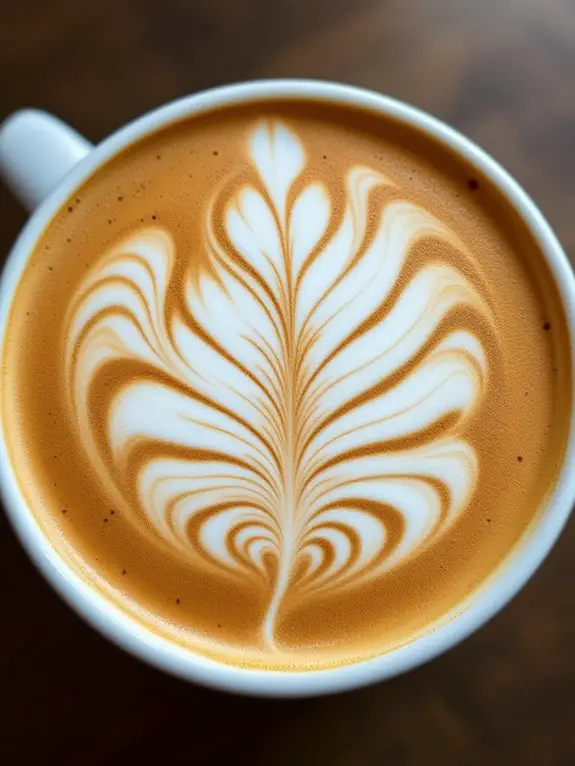
Once baristas have mastered the basic dot pattern, a classic rosetta beckons like a siren song – beautiful, alluring, and ready to crush the spirits of overconfident beginners.
The key steps to creating this leafy design include:
- Starting with a steady wiggle motion
- Moving the pitcher slowly forward
- Pulling through the center to create the stem
Many first-timers end up with what looks more like a feathered slug than the elegant fern pattern they envisioned. That’s perfectly normal! Even experienced baristas sometimes produce what they lovingly call “abstract art.“
The trick is finding the sweet spot between speed and control. Too fast, and you’ll create a mess that looks like a coffee tornado hit your cup. Too slow, and your design will sink faster than a lead balloon in your latte.
The Easy Apple Design

For aspiring latte artists seeking refuge from the rosetta’s complexity, creating an apple design offers a delightful path to picture-perfect pours. Unlike its fussy floral cousins, this fruity design only requires three basic moves: a circle, a stem, and a leaf.
The key steps are invigoratingly simple:
- Pour a round blob (like drawing a cookie with milk)
- Add a tiny curved line at the top for the stem
- Finish with a small teardrop shape for the leaf
What makes this design so beginner-friendly is its forgiving nature. Even wobbly circles can pass as “rustic” apples, and slightly crooked stems just add character. It’s the perfect design for those days when your hands aren’t steady enough for intricate patterns but you still want to impress your Instagram followers.
Making Your First Tulip
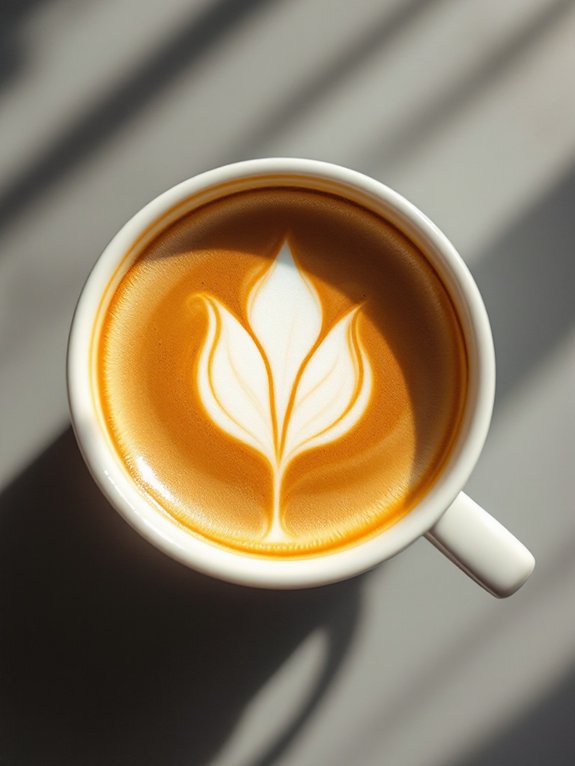
With the apple design mastered, ambitious baristas often set their sights on the beloved tulip pattern, a design that sits comfortably between “rookie” and “coffee shop pro.”
Creating a tulip might seem challenging at first, like trying to paint the Mona Lisa with hot milk, but breaking it down into simple shapes makes it far less intimidating.
The basic tulip consists of three simple steps:
- Pour a small dot in the center
- Add two larger dots above it
- Pull through with a gentle line
Many beginners get frustrated when their tulips look more like squished mushrooms or abstract blobs. Don’t worry – even professional baristas once created designs that looked like coffee-stained Rorschach tests.
The key is to maintain steady hand movement and consistent milk texture, much like a zen master painting with a brush. For best results, ensure your steamed milk temperature stays between 150-155°F to achieve the perfect microfoam consistency for your design.
The Beginner-Friendly Bear Face
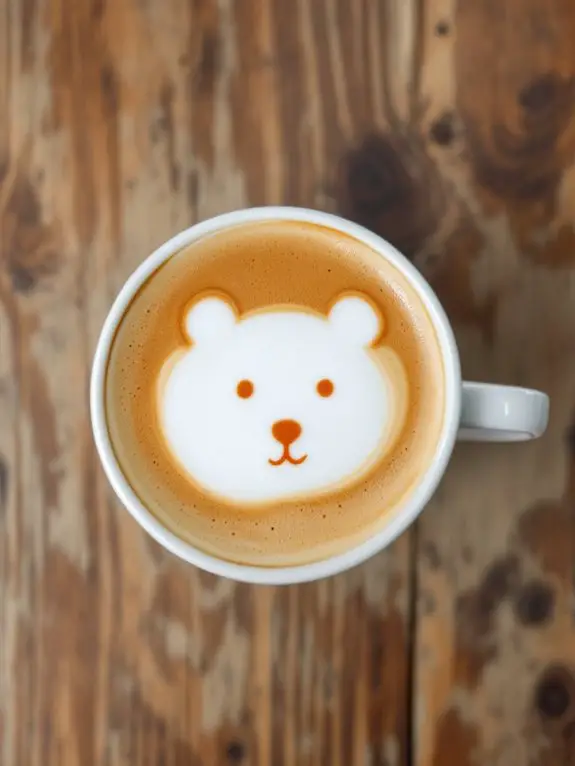
Although many latte artists dream of creating intricate rosettes and complex mandalas, the bear face design offers a delightfully simple starting point that never fails to bring smiles to customers’ faces. This adorable creation requires just three basic elements:
- Two round foam circles for ears
- One larger circle for the face
- A simple snout with dots for nose and mouth
What makes the bear face so approachable is its forgiving nature. Those slightly uneven ears? They’re just giving your bear “personality.” That wobbly snout? Now it looks like your bear is smirking!
Mastering latte art starts with simple designs like the beloved bear face – proof that you don’t need complexity to delight customers.
Even veteran baristas admit to falling back on this crowd-pleasing design when they’re having an off day. After all, there’s something undeniably charming about serving someone their morning coffee with a foam bear winking back at them.
Pouring a Basic Wave Pattern
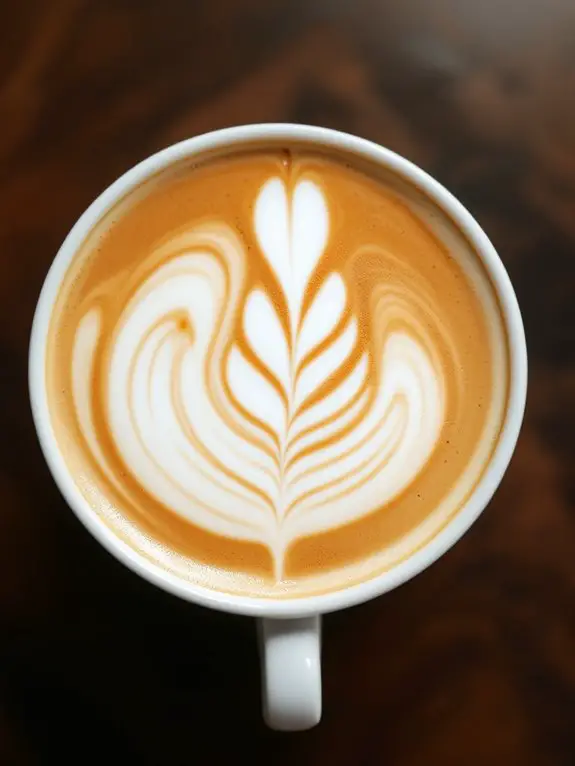
The basic wave pattern ranks as a true milestone in any barista’s latte art journey, marking the change from simple shapes to flowing designs. Think of it as learning to dance – first you master the basic step, then you’re ready to waltz across that creamy canvas!
To create the perfect wave:
- Start with a steady stream from the center
- Gently wiggle your pitcher side to side
- Move backward slowly while maintaining flow
- End with a quick pull-through
Don’t worry if your first attempts look more like zigzags gone wrong – every barista has been there! Every veteran barista confessed her early waves looked more like “coffee having a seizure” than actual waves.
The key is rhythm. Once you find your pouring groove, those waves will start rolling in naturally. Just like with pour over coffee, maintaining a steady, consistent pour rate is crucial for achieving the desired pattern.
Remember that lattes require minimal frothing time of just 3-6 seconds to achieve the ideal milk texture for creating these designs.
The Simple Swan Design

Many aspiring baristas consider the swan design their “eureka moment” in latte art, transforming a simple heart into an elegant bird with just a few strategic wiggles and pulls.
It’s like magic – one moment you’re pouring what looks like a wonky heart, and suddenly, with a quick flick of the wrist, you’ve created a graceful swan floating on coffee.
The basic steps are surprisingly straightforward:
- Start with a regular heart pour
- Pull through the middle to create the neck
- Wiggle slightly for feather details
- Finish with a small dot for the head
While perfecting the swan might lead to a few coffee casualties (we’ve all had those “headless bird” moments), it’s the first design that makes beginners feel like real artists. Just remember: if your swan looks more like a rubber duck, you’re on the right track!
Creating a Stacked Heart

Moving from floating swans to layered hearts, baristas can expand their artistic repertoire with a design that’s deceptively simple yet endlessly impressive.
The stacked heart begins with a basic heart shape, but here’s where things get interesting: rather than stopping there, artists create a second heart directly above the first, like a caffeinated game of Tetris.
Key steps for success:
- Start with a wider base heart
- Pull through slightly slower than usual
- Add the second heart with a gentler pour
- Connect the shapes with a delicate wiggle
Many beginners find their first attempts looking more like squished mushrooms than romantic symbols, but that’s part of the charm.
As one veteran barista jokes, “I made about fifty broken hearts before I managed to stack them properly!“
The Basic Leaf Pattern
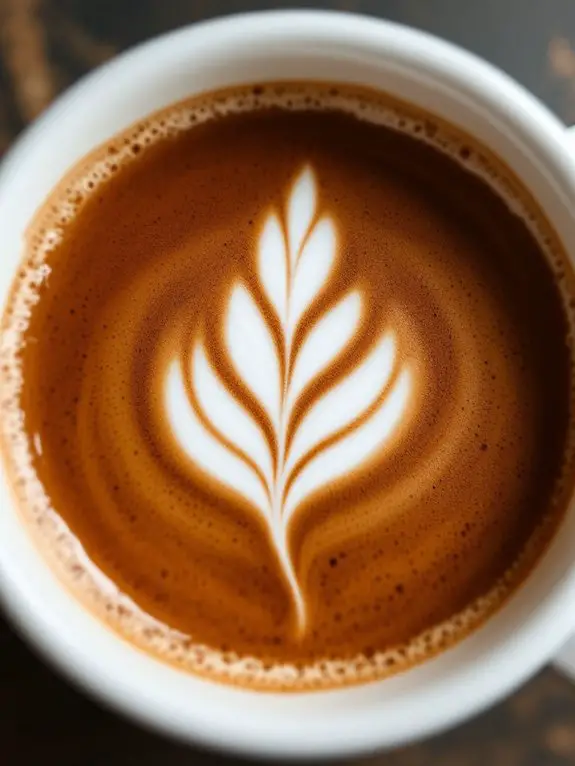
Among classic latte art designs, few patterns inspire as much confidence in beginners as the beloved leaf, which resembles everything from delicate ferns to questionable Christmas trees depending on one’s skill level.
The technique starts with a steady pour from the center, followed by a gentle wiggle motion that creates those characteristic leaf-like ridges. Baristas often joke that their first attempts looked more like failed Rorschach tests than actual foliage.
Key elements for success:
- Position your cup at a slight angle
- Pour with consistent pressure
- Wiggle gently (think tiny waves, not earthquake)
- End with a clean “pull-through” stroke
Your First Multi-Layer Rosetta
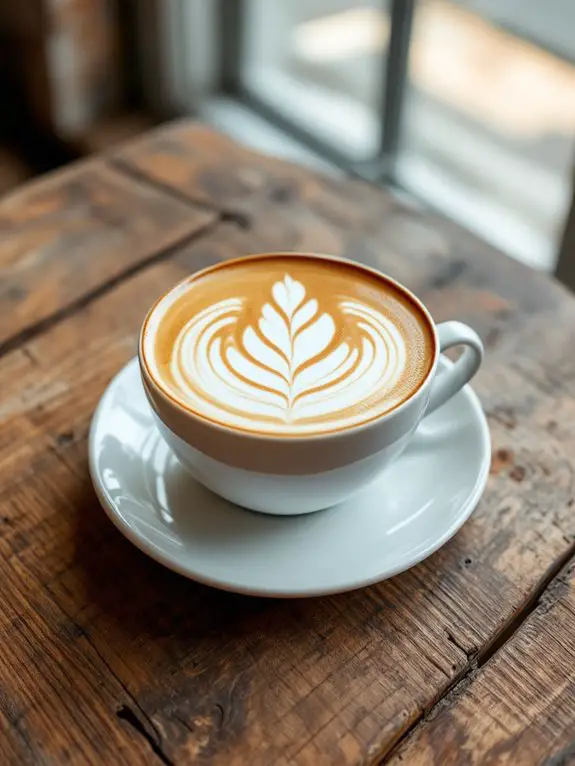
Once baristas have mastered the basic leaf, they often set their sights on the multi-layer rosetta, a pattern that makes even seasoned professionals break into a nervous sweat.
The key steps include:
- Starting with a gentle wiggle motion
- Building layers from the bottom up
- Drawing through the center with a final strike
Like trying to pat your head while rubbing your stomach, the multi-layer rosetta demands coordination that’ll make your brain hurt. Many baristas report their first attempts looking more like abstract modern art than the delicate fern-like pattern they were aiming for.
The trick is to maintain consistent speed and pressure throughout the pour. As one café owner likes to say, “It’s like dancing with hot milk – you’ve got to lead with confidence, even if your knees are shaking!”
Taking a few deep breaths before attempting this advanced design can help steady your hands and improve your focus.
Pouring from a 45-degree angle while maintaining steady control is essential for achieving clean, defined layers in your rosetta pattern.


Just tried the simple dot pattern, and wow, didn’t think I could do it but it looks kinda cool! Emma, you made it sound so doable, thanks! gonna try the swan next, wish me luck lol
Go for it! The swan’s a bit tricky but super rewarding once you get it right.
Did you use any special tools for the dot pattern or just the steamer pitcher?
Managed to pull off the classic rosetta after a gazillion tries haha. This article’s a lifesaver for night before exam stress. Also, making coffee art instead of studying, but hey, we all need a break, right? Emma, you got any tips for keeping the hand steady during the pour?
I found the easy apple design quite charming. It complements my apple pastries wonderfully. I wonder though if there’s a way to make the design a bit more intricate without significantly elevating the difficulty level.
doing the bear face tomorrow for my grandkids, they gonna love it. easy instructions, thanks Emma.
nailed the basic wave pattern on my first try, feeling pretty stoked! articles like these make mornings better.